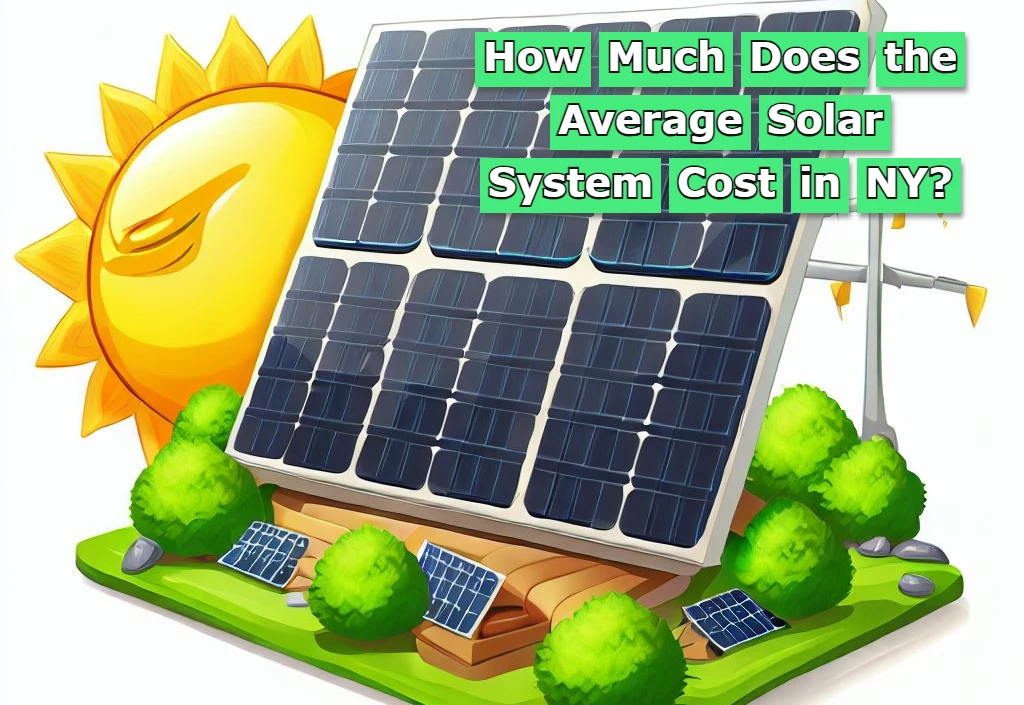Solar System Cost in NY: Solar power has gained considerable popularity in New York State as the demand for renewable energy sources grows. Harnessing the sun’s power to generate electricity helps reduce carbon emissions and presents an opportunity for homeowners and businesses to save on energy costs. However, a pertinent question arises: “How much does the average solar system cost in NY?” We will explore the factors that influence the cost of solar systems in New York and provide insights into the expenses associated with adopting solar energy.

Factors that influence the cost of solar systems in New York
1. Size of the Solar System:
The cost of an average solar system in New York heavily depends on its size, measured in kilowatts (kW) or megawatts (MW). A typical residential solar system in New York can range from 3 kW to 10 kW, depending on the household’s energy needs. Larger systems generate more electricity but also come with a higher upfront cost. It’s important for homeowners to assess their energy consumption and consider their budget when determining the optimal size for their solar system. Commercial and industrial installations, on the other hand, may require larger systems to meet their energy demands.
2. Equipment and Components:
The components of a solar system, including solar panels, inverters, mounting structures, and wiring, contribute significantly to the overall cost. High-quality components may incur a higher initial expense but often offer better efficiency, longer lifespans, and improved warranties. In New York, where weather conditions can alter, selecting robust and reliable components can enhance the system’s performance and longevity. Additionally, advanced technologies such as microinverters or monocrystalline solar panels can impact the cost while potentially delivering higher energy output.
3. Installation Costs:
Installation costs play a crucial role in the overall expense of a solar system in New York. The complexity of installation, roof type, and local labor rates can influence the installation expenses. Hiring experienced professionals ensures the system is correctly installed, adhering to safety standards and local regulations. Installation costs encompass labor charges, permits, and any necessary electrical work. While opting for a DIY installation might appear cost-effective, professional installation guarantees optimal performance and minimizes the risk of potential issues.
4. Location and Solar Potential:
New York’s geographic location and solar potential also influence the cost of solar systems. The state experiences varying levels of sunlight throughout the year, with regions upstate receiving less sunlight than downstate areas. Solar potential impacts the energy generation capacity of a solar system, influencing its size and cost. To estimate the system’s efficiency and overall cost accurately, it’s paramount to regard the solar irradiance of your specific location in New York.
5. Incentives, Rebates, and Tax Credits:
Government incentives, rebates, and tax credits can offset the cost of a solar system in New York. The state has programs encouraging solar energy adoption, such as the New York State Solar Equipment Tax Credit and the NY-Sun Incentive Program. These incentives can significantly reduce the upfront investment, making solar energy more accessible and cost-effective for homeowners and businesses. Researching and leveraging available incentives is crucial for those considering installing a solar system in New York.
6. Economic Considerations and Return on Investment:
The economic considerations surrounding a solar system extend exceeding the initial installation cost. While the upfront investment might be substantial, the long-term advantages can make it a financially prudent decision. You can reduce or eliminate your electricity bills by generating your electricity, potentially achieving a positive return on investment (ROI) over time. As energy prices continue to rise, the savings from a solar system become more pronounced, contributing to a quicker ROI and long-term economic advantages.
7. Maintenance and Lifespan:
Solar systems are designed to be durable and require minimal maintenance. Most solar panels come with warranties ranging from 20 to 25 years, ensuring consistent performance over an extended period. Periodic cleaning and occasional inspections are usually sufficient to maintain optimal energy generation. The low maintenance requirements contribute to long-term savings by reducing ongoing expenses. Investing in a well-maintained system guarantees a reliable source of energy and extends its operational lifespan.
Check: How to Start A Construction Company?
Final Words:
The cost of an average solar system in New York varies based on factors such as the system’s size, components, installation expenses, solar potential, and available incentives. While the initial investment might appear substantial, the potential for energy savings, reduced reliance on conventional energy sources, and positive environmental impact make solar systems an attractive option for New York homeowners and businesses.
Thorough research, accurate assessment of your energy needs, and leveraging government incentives are essential steps in making an informed decision about adopting solar energy. With advancements in technology and decreasing costs, solar power continues to be a viable and sustainable solution for a greener future in the Empire State. You can also compare the estimated cost told by your local solar experts with the NY solar cost explained by EcoGen America.
Tags: Solar system cost in ny calculator, solar panel cost calculator new york, how much do solar panels cost for a 2,000 square foot house, average cost of solar panels in ny, free solar panels new york, ny solar incentives, solar panel installation nyc, new york state solar program.
